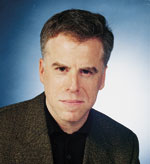| |
|
 "The
only way newspapers can survive is to give readers wat they
don't get anywhere else. At the same time, there's a recognition
that readers have less time and patience. I see these two
pressures colliding." "The
only way newspapers can survive is to give readers wat they
don't get anywhere else. At the same time, there's a recognition
that readers have less time and patience. I see these two
pressures colliding."
TOM
ROSENSTIEL
SLAPS THE PAPER AND TURNS THE PAGE. He's beholding one edition
of journalism's future, and Rosenstiel '78 isn't impressed.
In his office at the Washington-based Project for Excellence
in Journalism, Rosenstiel slides quickly over the slick graphics,
light fare, and bite-sized morsels of a typical issue of USA
Today. It's seemingly newspaper-as-Muzak: technically
competent, typically forgettable, and seemingly everywhere.
"The
problem with USA Today," he says, "is that its hometown
is an airport. It's hit on an important notion, which is that
people have a limited amount of time, but not all things should
be condensed."
Some
things, that is to say, need the kind of fact-centered fleshing-out
that marks journalism at its most memorable, and that suffers
most grievously under the keep-it-tight structures of USA
Today and its kin. Easily digestible news may suit a speeded-up
society, but tidbits can also quickly lose flavor. For journalists,
an eye-opening number of whom apprenticed at The Oberlin
Review or WOBC, a fundamental challenge is balancing what
the audience wants with what it needs.
"There
are two conflicting currents in journalism," said Andrew Zajac
'79, technology reporter with The Chicago Tribune.
"The only way newspapers can survive is to give readers what
they don't get anywhere else. At the same time, there's a
recognition that readers have less time and patience. I see
these two pressures colliding."
Rosenstiel
and Zajac, to be sure, also recognize the merits of the paper
that claims the highest circulation of any in the country.
A former Los Angeles Times media reporter and Newsweek
congressional correspondent, Rosenstiel appreciates USA
Today's comprehensive sports section, the centerpiece
features, and the hard-news fortifying what once was notoriously
thin porridge. Building for the future, the paper has been
luring supremely talented reporters away from the likes of
The Washington Post. Critiquing USA Today certainly
isn't what it used to be--McNews, some dubbed it. An invidious
influence on the nation's shrinking population of 1,489 daily
newspapers, reporters once sobbed into their beers.
The
truth is, USA Today is both a better newspaper than
it used to be, and yesterday's revolution. The paper claims
a circulation of 2.2 million and is apparently turning a profit
after losing hundreds of millions of dollars of the Gannett
Newspaper Company's money. Its color-and-graphic influence
has irrevocably spread far beyond Gannett's 74-daily newspaper
empire. The nation's journalists, meanwhile, have turned their
ulcers elsewhere.
Now
it's the broader information revolution, manifested in the
Internet and 24/7 cable television, that empowers journalists
but also leaves them scrambling in a world of media mega-mergers.
Attention spans and audiences are fragmenting, prompting some
journalists to bellow louder and others to throw up their
hands in despair. Rosenstiel and co-author Bill Kovach identified
the trends in their book Warp Speed, using the otherwise
unedifying tale of President Clinton and Monica Lewinsky to
illustrate how assertion has replaced verification, information
has merged with entertainment, and heat has become mistaken
for light.
 |
|
Tom
Rosenstiel
|
"There
are two primary trends in journalism going on," Rosenstiel
said. "There's the blurring of the line between entertainment
and news, and there's the slide away from reporting into argument...at
The New York Times, that means more interpretive reporting,
and on cable television, it means more shouting."
Some adaptations
make sense in a busy world where people only devote 20 minutes
a day to news consumption. People are fascinating, process
is boring. People want news they can use. Drama is compelling.
But what's interesting, immediately useful, and dramatic may
not always be synonymous with what's important. One
Washington-based Oberlin graduate recalled receiving an editor's
memo ordering "fewer policy
stories." The bemused political reporter likened this to "a
sports writer being ordered to write less about athleticism."
In
Rosenstiel's junior year at Oberlin, 1977, 66 percent of the
stories in seven major news outlets dealt with government
and policy. One in three of all TIME and Newsweek
covers represented a political or international figure. By
1997, a survey by the Committee of Concerned Journalists found
that government and policy stories had fallen to 49 percent.
Only one in ten of TIME or Newsweek covers bothered
with politics or international figures. Celebrities and sensation
help fill the vacuum. In 1977, less than 1 percent of network
news stories dealt with scandal. By 1997, this had risen to
15 percent.
next
page
|